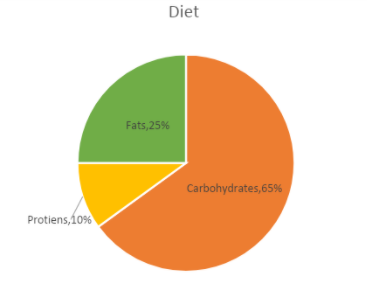
Following pie chart shows the consumption of the balanced diet, provided in the mid-day meal of a Primary school. If a child needs 2500 calories in his food daily, find the amount of each (in calories) in his daily food intake.


Answer
492.9k+ views
Hint: We are given the total calories. From the pie chart, we have the percentage of each nutrient. So we can find the amount of each nutrient by taking the respective percentage of the nutrient in the balanced diet from the pie chart.
Complete step by step solution: We are given that the total calories the child needs are 2500.
From the pie chart, the percentage of carbohydrate is $65\% $. So the amount of carbohydrates is $65\% $ of 2500.
Amount of carbohydrates $ = 2500 \times 65\% $
On writing the percentage as fraction, we get,
$ = 2500 \times \dfrac{{65}}{{100}}$
On cancelling the zeros, we get,
$ = 25 \times 65$
$ = 1625$
Therefore the amount of carbohydrates is 1625 calories.
From the pie chart, the percentage of proteins is $10\% $. So the amount of proteins is $10\% $ of 2500.
Amount of proteins$ = 2500 \times 10\% $
On writing the percentage as fraction, we get,
$ = 2500 \times \dfrac{{10}}{{100}}$
On cancelling the zeros, we get,
$ = 250$
Therefore the amount of proteins is 250 calories.
From the pie chart, the percentage of fats is $25\% $. So the amount of fats is $25\% $ of 2500.
Amount of carbohydrates $ = 2500 \times 25\% $
On writing the percentage as fraction, we get,
$ = 2500 \times \dfrac{{25}}{{100}}$
On cancelling the zeros, we get,
$ = 25 \times 25$
$ = 625$
Therefore the amount of fats is 625 calories.
Thus, the daily intake of a child has 1625 calories of carbohydrates, 250 calories of proteins and 625 calories of fats.
Note: A pie chart is a diagrammatic representation of relative data. In a pie chart, a full circle is divided into slices and each slice represents each data. The arc length, the central angle and area of each slice will be proportional to the quantity of the data it represents. In this problem, we must find the amount of each nutrient. This can be found in any order. After finding the amount of all the nutrients, we can take their sum and check whether it gives the total required diet. After finding any two quantities, the third one can be found out by subtracting their sum from the total.
Complete step by step solution: We are given that the total calories the child needs are 2500.
From the pie chart, the percentage of carbohydrate is $65\% $. So the amount of carbohydrates is $65\% $ of 2500.
Amount of carbohydrates $ = 2500 \times 65\% $
On writing the percentage as fraction, we get,
$ = 2500 \times \dfrac{{65}}{{100}}$
On cancelling the zeros, we get,
$ = 25 \times 65$
$ = 1625$
Therefore the amount of carbohydrates is 1625 calories.
From the pie chart, the percentage of proteins is $10\% $. So the amount of proteins is $10\% $ of 2500.
Amount of proteins$ = 2500 \times 10\% $
On writing the percentage as fraction, we get,
$ = 2500 \times \dfrac{{10}}{{100}}$
On cancelling the zeros, we get,
$ = 250$
Therefore the amount of proteins is 250 calories.
From the pie chart, the percentage of fats is $25\% $. So the amount of fats is $25\% $ of 2500.
Amount of carbohydrates $ = 2500 \times 25\% $
On writing the percentage as fraction, we get,
$ = 2500 \times \dfrac{{25}}{{100}}$
On cancelling the zeros, we get,
$ = 25 \times 25$
$ = 625$
Therefore the amount of fats is 625 calories.
Thus, the daily intake of a child has 1625 calories of carbohydrates, 250 calories of proteins and 625 calories of fats.
Note: A pie chart is a diagrammatic representation of relative data. In a pie chart, a full circle is divided into slices and each slice represents each data. The arc length, the central angle and area of each slice will be proportional to the quantity of the data it represents. In this problem, we must find the amount of each nutrient. This can be found in any order. After finding the amount of all the nutrients, we can take their sum and check whether it gives the total required diet. After finding any two quantities, the third one can be found out by subtracting their sum from the total.
Recently Updated Pages
Master Class 9 General Knowledge: Engaging Questions & Answers for Success

Master Class 9 English: Engaging Questions & Answers for Success

Master Class 9 Science: Engaging Questions & Answers for Success

Master Class 9 Social Science: Engaging Questions & Answers for Success

Master Class 9 Maths: Engaging Questions & Answers for Success

Class 9 Question and Answer - Your Ultimate Solutions Guide

Trending doubts
Fill the blanks with the suitable prepositions 1 The class 9 english CBSE

The first successful textile mill was established in class 9 social science CBSE

Difference Between Plant Cell and Animal Cell

Given that HCF 306 657 9 find the LCM 306 657 class 9 maths CBSE

The highest mountain peak in India is A Kanchenjunga class 9 social science CBSE

Name one staple crop of India and the regions where class 9 social science CBSE




